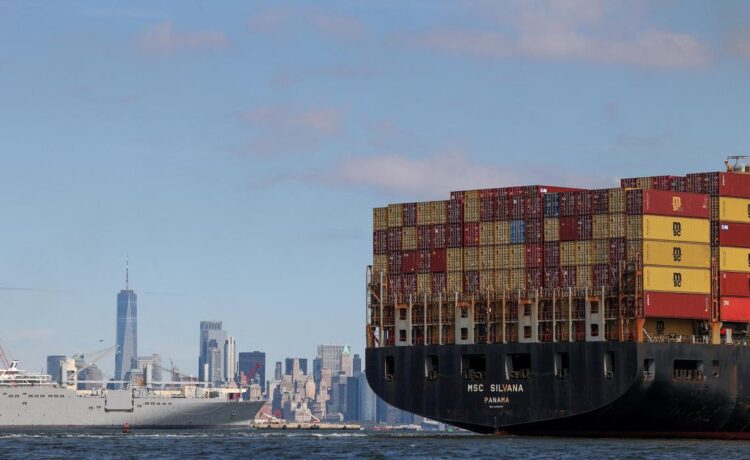tokyo – Asian stock markets slumped on Feb 3 and US equity futures pointed sharply lower after US President Donald Trump’s tariffs on Canada, Mexico and China triggered fears of a broad trade war and hit to global growth.
The US dollar meanwhile shot to a record high against the Chinese yuan in offshore trading, and jumped to the highest since 2003 against Canada’s currency and the strongest since 2022 versus Mexico’s peso.
The greenback surge also drove the Singapore dollar down 0.9 per cent to 1.3686 per US dollar as at 9.58am.
Behind the rally in the US dollar is the bet that tariffs will fuel inflationary pressures and keep US interest rates elevated, while also hurting foreign economies more than the United States and adding to the greenback’s safe-haven lure. Foreign currencies get hurt as American demand declines for costlier imports.
Singapore’s Straits Times Index was down 0.7 per cent as at 9.53am local time, paring heavier losses.
Hong Kong’s Hang Seng Index slumped 2 per cent, while mainland China markets remain shut until Feb 5 for Chinese New Year holidays.
Japan’s Nikkei share average tumbled 1.9 per cent, and Australia’s benchmark – which often functions as a proxy for Chinese markets – fell 1.7 per cent.
Mr Trump slapped Canada and Mexico with duties of 25 per cent and China with a 10 per cent levy at the weekend, as he had threatened in January, calling the measures necessary to combat illegal immigration and the drug trade.
Canada and Mexico immediately vowed retaliatory measures, and China said it would challenge Trump’s levies at the World Trade Organisation.
The tariffs, outlined in three executive orders, are due to take effect on Feb 4.
Oil prices jumped at the market open on fears of a trade war and disruption in crude supply from two of the United States’ biggest suppliers.
US West Texas Intermediate crude was at US$74.27 a barrel, up US$1.74, or 2.4 per cent, by 11.19pm GMT, after hitting more than a week’s high at US$75.18 a barrel earlier in the session.
Brent crude futures rose 73 US cents, or 1 per cent, to US$76.40 a barrel.
The rapid escalation in trade tensions is fuelling a flight to safe haven assets as uncertainty mounts over everything from inflation and central bank policy easing to Mr Trump’s next move.
Mr Trump’s move was the first strike in what could usher in a destructive global trade war and drive a surge in US inflation that would “come even faster and be larger than we initially expected,” said Paul Ashworth of Capital Economics.
A model gauging the economic impact of Mr Trump’s tariff plan from EY chief economist Greg Daco suggests it would reduce US growth by 1.5 percentage points in 2025, throw Canada and Mexico into recession and usher in “stagflation” at home.
Barclays strategists previously estimated that the tariffs could create a 2.8 per cent drag on S&P 500 company earnings, including the projected fallout from retaliatory measures from the targeted countries.
US stock futures were also hit with S&P 500 futures sliding 1.7 per cent, after a 0.5 per cent retreat for the cash index on Friday (Jan 31), when the White House reiterated Mr Trump’s plan to announce tariffs the next day. Nasdaq futures slumped 2.5 per cent.
The US dollar advanced 0.7 per cent to 7.2552 yuan in the offshore market on Feb 3, having earlier pushed to the record high of 7.3765 yuan. There will be no official onshore trading due to holidays.
The greenback climbed 2.3 per cent to 21.15 Mexican pesos, crossing the 21 peso line for the first time since July 2022, and rose 1.4 per cent to C$1.4755, a level not seen since 2003.
The euro plunged as much as 2.3 per cent to $1.0125 – the lowest level since November 2022 with Europe also potentially in Mr Trump’s tariff crosshairs.
Mr Trump said he will “definitely” place new tariffs on the European Union, reiterating complaints about the US trade deficit with the bloc and what he sees as insufficient EU imports of American cars and agricultural products.
He did not specify a level or timeline. “I wouldn’t say there’s a timeline, but it’s going to be pretty soon,” he told reporters.
Japan’s yen was more resilient, losing 0.2 per cent to 155.53 per dollar.
Cryptocurrency Bitcoin tumbled as much as 5.8 per cent to a three-week low of US$96,191 amid the flight out of risky assets. REUTERS, BLOOMBERG
Join ST’s Telegram channel and get the latest breaking news delivered to you.

